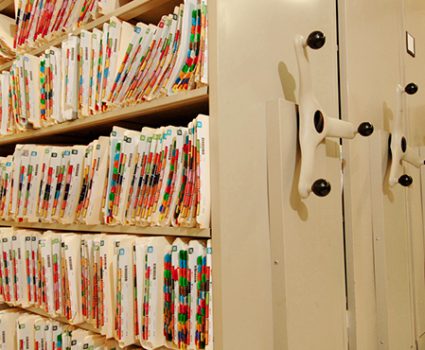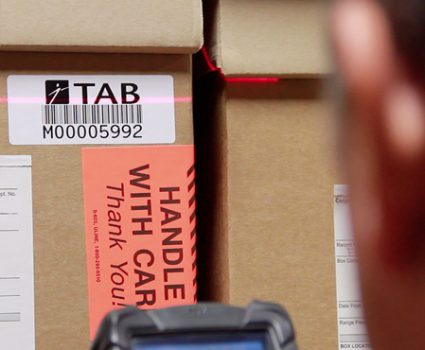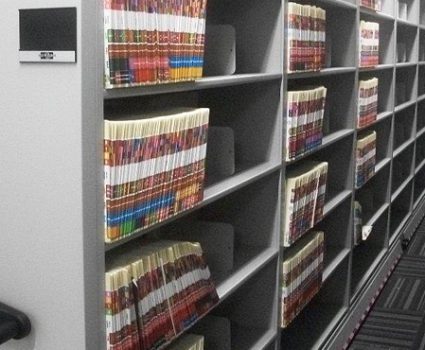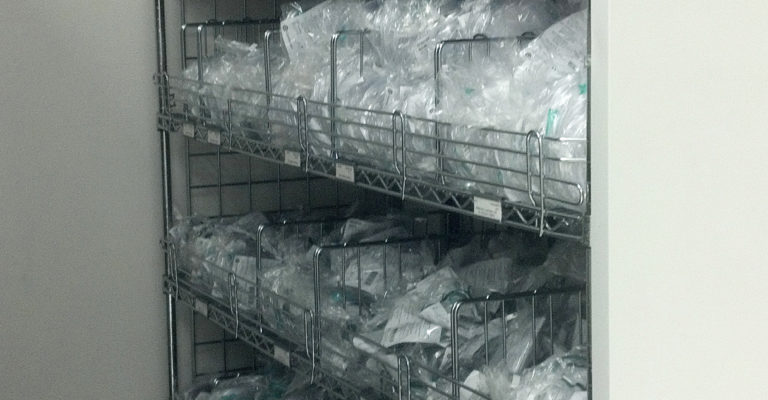
Three things to consider about medical storage
It’s an important time to re-examine your medical equipment storage. Amidst a need for additional patient rooms and beds are rising real estate costs (hospitals account for over $1 trillion1 in owned property), an increased need for secure storage and storage requests that are unique to the healthcare industry.
We’ll take you through three things that will help you make responsible purchasing decisions, which then helps to lower costs; maximize space; remain compliant & keep items secure.
|
1.0 Space
A recent survey in the Health Facilities Management Magazine talks about the increased importance of patient satisfaction including converting semi-private rooms to private rooms (66% of respondents) and increasing the size of patient rooms (49% of respondents)2.
For this to be a reality, additional space is needed and there are only two ways to gain that space. New construction (costs average around $400/sq. ft.) or being smarter about how to utilize your current space.
Below are a few thoughts to help with utilizing your current space:
a. Compact mobile shelving units allow all supplies to be stored in one central location.
b. A mobile shelving install doubles space by eliminating aisles and compacting cabinets or shelving into a much smaller amount of space.
c. Reduce the distance between items3. A centralized storage area utilizing mobile shelving reduces the time it takes to retrieve an item in an emergency and limits the amount of times an item gets re-ordered because it can’t be found.
2.0 Security
In a hospital, pharmaceuticals and medical equipment need to be kept secure. In most organizations that means locked and only available to authorized healthcare professionals. Although many use a locking storage cabinet, there are several other options available for secure storage.
These options include:
a. Rolling security doors for both static and high-density shelving
— Rollok and tambour doors make any existing mobile storage unit completely secure and compliant
— Includes a keyed lock to secure your collections
— Optional extenders to allow for protruding items of large sizes and shapes
— Security components are easily installed across the aisle, on shelving fronts, and on end panels
— Metal caging helps prevent access to stored materials from above and between aisles
— Locking aisles prevent frontal access to stored materials
While deciding the best secure storage options for your hospital, it is wise to consider additional assets that should be secured in some fashion including linens, scrubs, gowns and sanitation supplies. See the image below for an example of a hospital using Rollok doors on mobile storage for their linens.
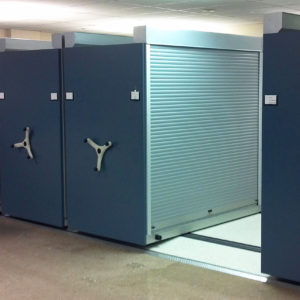 .
. 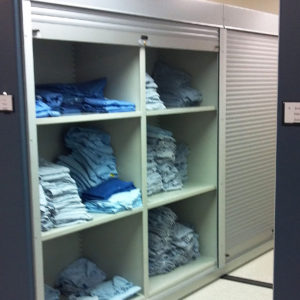
3.0 Unique Storage Needs
There is not one solution that is right for every item that needs to be stored in a hospital. More than any other industry, hospitals have a number of unique items that need to be stored, secured and easy to access.
We have a few tips to help you overcome these unique needs:
a. Use of a mobile system allows for the accommodation of a wide variety of items that may be found in a hospital. This may include: archived records, radiology films, multi-media library resources, pharmaceuticals, medical supplies, samples, linens and laundry, personal effects, sterile materials, freezer storage and more.
b. Remove items from boxes and store in clear containers4 so you can see exactly what you’re looking for. This is especially important in locked shelving units when supplies need to be accessed quickly.
c. Don’t be afraid to contact an expert about creating a custom storage solution. One TAB partner had a unique storage challenge (image below). The pharmacy area in the hospital needed an efficient storage solution for medicine and a variety of other items including IV bags, catheter tubes and different medicines in individual dosages.
— The solution used was TAB’s lateral mobile system with a variety of plastic bins hung on peg boards. The variety of different sized bins/flat shelves and hooks provided the ability to store a variety of sizes/types of products. Color coding the bins helped with dosage recognition.
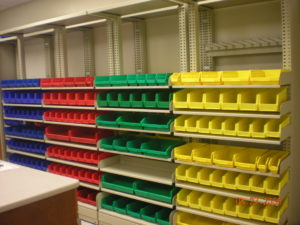
Next Steps:
— Learn more about our storage options for hospitals and other healthcare facilities
— Download our mobile storage buyer’s guide
— Read our previous blog post on healthcare information management and how to protect paper medical records
—Contact an expert at TAB and let them know your issue or request a quote.
Sources
1. CBRE: “New Study Spotlights Opportunities for Hospitals to Control Costs and Secure Capital”www.cbre.us” 04.04.2018
2. Suzanna Hoppszallern, Rebecca Vesely and Jamie Morgan. Patient experience drives design and construction “www.hfmmagazine.com” Health Facilities Management. 02.03.2016
3/4. Remote Medical International: 6 Tips to Better Manage Your Medical Supplies “www.remotemedical.com” 06.27.17



